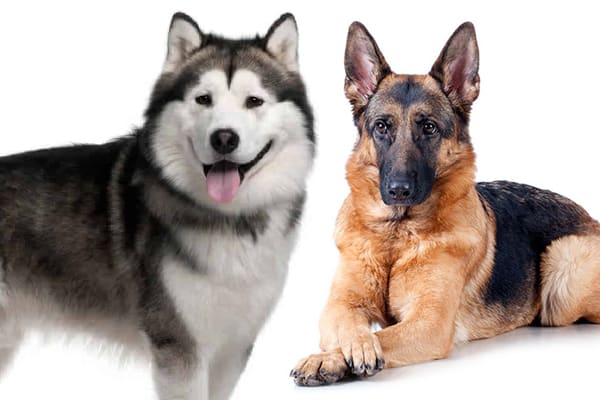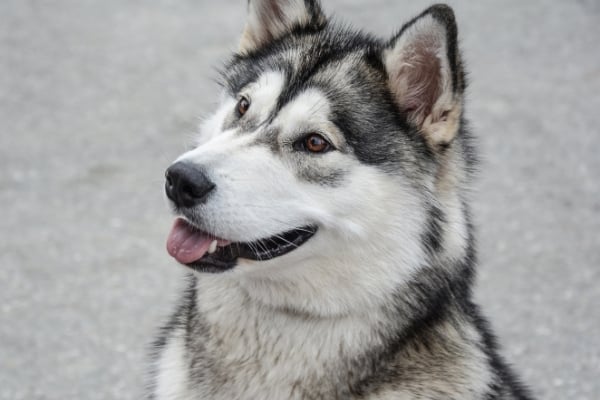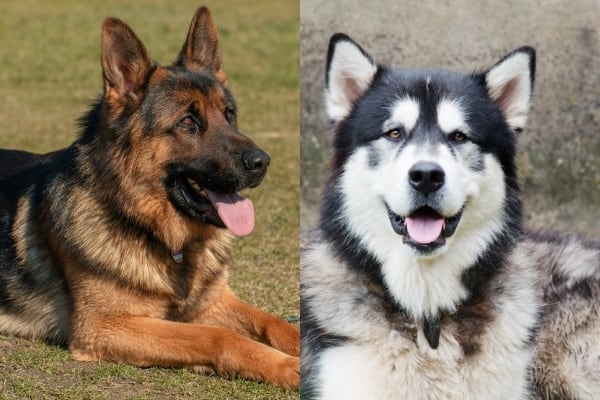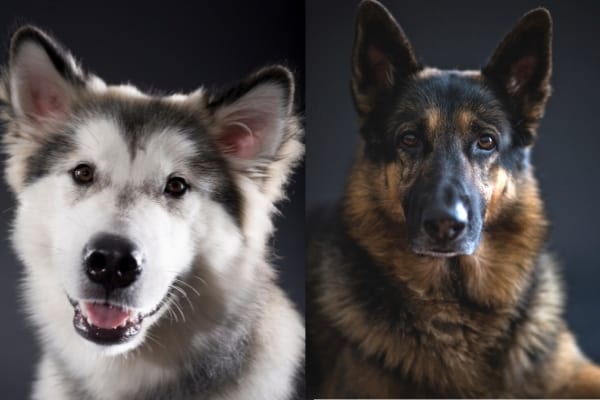Could Your New Best Friend Be An Alaskan Malamute Or A German Shepherd Dog?
The Alaskan Malamute (or “Mal”) is known as the “King of The North” for its abilities and noble stature in the Alaskan Wilderness.
The German Shepherd Dog (or “GSD”) is known for its work utility in military and police work around Europe and North America.
If you are considering one of these breeds as your next best friend, there is a lot to consider before you bring one into your home.
Each dog has its own personality, but generally, there are characteristics and traits that each breed has that you should research.
Experts and owners of Alaskan Malamute would describe their dogs the following way: Active, affectionate, gentle, independent, faithful, playful and stubborn.
Trainers and German Shepherd Dog owners would identify their dogs with words like confident, courageous, defender, energetic, intelligent, loyal, and smart.
To start your research, Animal Planet’s Dog’s 101 has some great introductory videos on The Alaskan Malamute and the German Shepherd.
Their experts cover many essential topics and some fascinating history about some of the famous members of the breeds.
German Shepherd vs Alaskan Malamute
Our Stories Begin…

The Alaskan Malamute and the German Shepherd Dog have very different beginnings.
According to the Alaskan Malamute Club of Belgium (AMCB), which promotes responsible breeding of purebred Mals, the breed originated in Siberia and came over to Alaska via the land bridge that once existed in the Bering Straits.
According to Wikipedia, It formed a symbiotic relationship with the Native Inuit Mahlemut Corporation as a companion to hunt seal, scare away polar bear, and haul heavy loads on sleds.
In the late 1800s when the Americans from the lower 48 states came to Alaska for the gold rush, the dog gained so much popularity, they mixed the malamute with other breeds to the point that the pure breed was almost wiped out.
The pure Malamute was brought back due to factors like the isolation of the Mahlemut Corporation, the American Kennel Club recognized the breed, and efforts of breeders who wanted to see the malamute continue on.
The Deutscher Schäferhund is the German name for the German (Deutscher) Shepherd (schäfer) Dog (hund).
According to the German Shepherd Dog Club Of America, the breed began in 1899 by Captain Max von Stephanitz.
Captain von Stephanitz bought his dog from a sheepherder and set the breed standards based on his newly acquired dog. He then began to breed and inbreed his dog’s line to create a breed that had the abilities he wanted for military use.
After World War I, American G.I.s brought some of these dogs home with them. Two of these lucky pups, Rin-Tin-Tin and Strongheart gained national attention for themselves, and their breed, in their silent movie performances that were shown around the country. You can see their stars on Hollywood Boulevard.
Through the years, the breeding focus changed based on needs. When the dogs were not needed for their working abilities, they were bred for their appearance and show qualities. Others were bred to be more submissive for the home.
In recent years, when the canine programs of the military and law enforcement services needed the working traits of the GSD, they sought dogs from Europe that maintained the working traits.

Lifestyle
Both of these breeds have a few things in common. They love to be active. If you look at their origins you can see why. One breed spent centuries hooked up to sleds running for days across frozen tundras.
The other was meant to work in almost any environment, working to protect their owner from dangerous situations or shepherd activities.
Another common trait is that you need to set authority early with these two breeds. More with the Mal than the GSD.
If you do not show them that you are the alpha leader in the household, then they will consider themselves the alpha.
As a result, training and obedience can become that much more difficult. One way to have your dog respond to your children is to have your kids work with your dog in training sessions. Children should be involved in all aspects of care for your dog to solidify their alpha authority.
Each breed has other instincts and traits that are apart of their breed makeup. The key is to fulfill these desires in your home setting.
This can be done as long as you know what they are looking for. Your training program should be consistent, and maintain a home environment that is safe for you and them.
Family
Malamutes are pack animals in the purest form. Two-legged or four-legged, their pack is their pack. They socialize well with other people and animals but make sure you supervise them with your young children.
Dogster says it best when they talk about their temperament. They never lose their “inner-puppy.” They love to play and goof around, but sometimes forget how powerful they are.
Their claws are designed to grip ice and their muscles have been evolved to pull hundreds of pounds. Mentally, they may think they are no bigger than your toddler.
Shepherds, on the other hand, are your friendly protectors. There are many examples of GSDs herding children away from danger. Whether it’s keeping them away from stairs, things outside, or other instances, your German Shepherd is your kid’s best protector.
German Shepherds also have an eagerness to please their owners. This is why training can be easy with positive and authoritative methods.
Health
Both breeds are bigger breeds. Big breed dogs have tendencies to develop hip dysplasia. According to the American Kennel Club (AKC), Hip Dysplasia is most common in large breeds like Great Danes, St. Bernards, Labrador Retrievers, and German Shepherd Dogs. It can be a hereditary condition, but can also develop due to many other factors.
The condition is when the ball sockets in the hip wear down and no longer rotate correctly in the socket. This can cause pain, stiffness, or lame the limb. Nutrition can play a big part in preventing the condition.
The nutrients glucosamine, chondroitin, and MSM are usually prescribed by veterinarians to treat arthritis that develops due to this condition.
Some dog food brands offer these nutrients as early as their puppy formulas to maintain your dog’s joints throughout their life span as a preventive measure.
Other conditions to look out for is bloat. It is also called a “twisted stomach” and is very dangerous. According to the AKC, they are not 100% sure why it happens but suspect it has something to do with when your dog eats too fast and takes in massive amounts of air.
The stomach flips and it prevents blood from flowing properly. The only way to fix the problem is to get your dog to your veterinarian as soon as possible for surgery. All dogs are susceptible, but bigger dogs are more prone especially Mals.

Training
Training these two breeds requires different methods. The key to success is to understand their needs. Both of these breeds require you to show them that you are the alpha of the pack. You are in charge.
This is true more for the Malamute than the Shepherd since Mal is more of an independent thinker and the GSD is eager to please.
The Malamute is a very intelligent breed and will get bored easily. When training them, if you try and train them on one skill only, they will become uninterested and their stubbornness will start to kick in. A better method may be to try multiple skills.
It is always recommended to contact a professional dog trainer to help you create a training program you and your dog can be successful together.
The German Shepherd Dog is eager to please and responds better to positive reinforcement. A few weeks of consistent training can have your dog through the basics and into some of the more complex training like bringing you the remote, closing doors, or other mid-level tasks.
Security
When it comes to protecting your home and your family, these two breeds could not be more different.
If a stranger were to break into your house, more than likely, the Malamute would protect the food, let the robber have the run of the place, and leave unharmed.
Malamutes love people but are protective of food. As O’Mal Alaskan Malamutes puts it, “Malamutes are NOT guarded dogs. The only thing they will guard is their food.”
Mals will guard their toys, food, kennels, and other possessions that they think are theirs. Pet parents that have tried to train them to perform as guard dogs have failed often.
The Mals have a high probability of turning on the owners due to trying to train them on something that is counter-intuitive to them.
Your Malamute will guard your home against small rodents though. Be prepared to find half-eaten mice, rats, squirrels, or other small creatures in your backyard or dark places rodents like to frequent.
Although Mals are not terriers, they are great at hunting, killing, and eating small animals. Some as big as rabbits.
We recommend getting a heavy-duty rake and a square-edge shovel for cleaning up the “evidence.” We also recommend a solid fence. Malamutes will also go after deer in your area.
In his article, Top 10 Best Guard Dog Breeds, Cesar Millan says this about the German Shepherd Dog:
“German Shepherds are bold, confident, and fearless. They are extremely intelligent and quick to learn commands, thus making them a favorite police dog breed.
German Shepherds have a calm demeanor when in a household but can quickly react when their family or home is threatened.”
German Shepherd Dogs’ trainability and eagerness to please make them the ideal dog for protection and guard work.
Their calm nature with their people will make them the ideal candidate for your daughter’s tea party, wearing a hat and bow.
At the same time, if your daughter is approached by someone with bad intentions, and she gives the command, that person will learn real quick why your daughter was the wrong target.
If you decide that you want to train your GSD to perform guard dog work, seek professional training from an accredited trainer in your area.
This type of training has to be done with special equipment and performed by trainers that know what they are doing to prevent you and your family from getting hurt.
Keep in mind that dogs do not understand the difference between pretending and real. When they are training, in their mind, it is for real.

Breed Specific Legislation (BSL)
The ASPCA defines Breed Specific Legislation (BSL) as “The blanket term for laws that either regulate or ban certain dog breeds in an effort to decrease dog attacks on humans or other animals.”
The reason we bring this up comes from the idea that both of these dog breeds show up on some city ordinances throughout the United States.
For a complete list, you can check out this list from Dogs Bite.org that shows the city ordinances by state.
We recommend that you first check with your city government to confirm the accuracy. We would not want you to find your new best friend, and then have to give him/her up due to active BSL regulations.
Living With The Child That Doesn’t Move Away
We have talked a lot about the various traits that these two breeds generally show. The Alaskan Malamute is an independent thinker that will love everybody, is very affectionate, playful, and needs to live a very active life.
The German Shepherd Dog needs activity, is eager to please, protects their people, and is a natural herder. They both need to know who is in charge.
In a lot of ways, your new best friend will also be that four-legged child that does not grow up and moves out of the house.
They may not always side with you in those playful arguments, because you are not holding the turkey sandwich at the time, but you could not imagine your life without them.
Your two-legged children will grow up, go to college (or whatever life has in store for them after high school), and move on with their lives as adults, but that four-legged child will still be there for you.






























